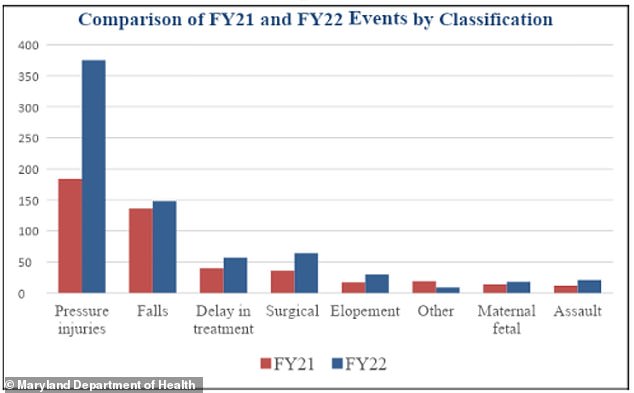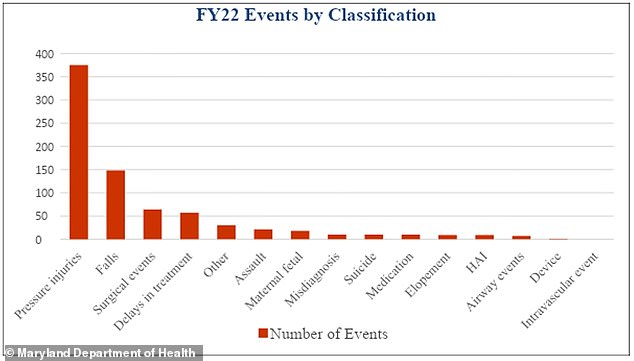Maryland becomes America’s healthcare blunder capital: Serious hospital errors have tripled since 2019 – including three patients who died when an engineer accidentally unplugged an oxygen machine
Dangerous medical blunders resulting in death or serious injury more than tripled at Maryland hospitals between 2019 and 2022.
A state report shows that 832 adverse events occurred between Oct. 1, 2021, and Sept. 30, 2022, which was also the highest since records began in 2004.
Of last year’s incidents, 769 were classified as the most serious or Level 1 events. defined as detrimental incidents resulting in death or serious disability.
In one case, a patient had surgery on one of his legs and ultimately had his other leg amputated due to a serious medical complication.
In another case in 2021, three people died after a maintenance worker accidentally shut off an unlabeled oxygen line.
Another blunder was that a premature baby with a low birth weight was given the wrong dose of steroids for almost two weeks.
The chart above shows the number of adverse events reported in Maryland hospitals from 2004 to 2022

The chart above shows the 2021 to 2022 comparison of different types of adverse events in Maryland hospitals

The chart above shows the number of different types of adverse events in Maryland hospitals in fiscal year 2022
Total events in 2022 were a 52 percent increase over 2021, and the highest the state has ever recorded since it started collecting data in 2004.
The report, which attributed the increase in adverse events in part to easing staffing and supply shortages during the COVID-19 pandemic, included results from 62 hospitals in the state of Maryland but did not identify which hospitals the events occurred in.
The Leapfrog Group, a private organization that evaluates hospital safety metrics, ranked Maryland 35th for patient safety, giving only nine hospitals in the state the highest Level A safety rating.
Of the side effects, pressure ulcer falls, treatment delays and surgical procedures accounted for 80 percent. The number of physical and sexual assaults within the hospital has increased by 75 percent in 2022.
Based on the findings, the report’s authors emphasized that hospitals must prioritize safety and optimize processes to avoid system failures that could lead to serious errors.
As part of the report, the authors highlighted several adverse events observed and provided “lessons learned” to guide hospital staff in preventing similar outcomes in the future.
Pressure ulcers, or pressure ulcers and bedsores, saw the largest increase, approximately doubling from 184 in 2021 to 375 in 2022.
These are injuries to the skin and soft tissue that result from constant or prolonged pressure on the skin, such as when a patient lies in a hospital bed without moving for an extended period of time.
Falls were the second most common side effects, showing a slight increase from 136 to 148.
In one fall, a patient fell in her room and hit her head, causing a subdural hematoma or bleeding in her brain. After developing symptoms such as nausea and headaches, tests revealed the patient’s condition, forcing her to be transferred to another facility and undergo brain surgery.
Going forward, the report’s authors recommend that patients be assessed for their fall risk, be informed of their fall risk, that hospital staff perform multiple tests to check for head injuries and that beds and fall alarms be operational.
Surgical side effects include anything involving foreign objects left in patients’ bodies, deaths in healthy patients undergoing low-risk procedures, and unexpected deaths during or immediately after surgery.
These incidents have doubled from 31 events in 2021 to 64 in 2022.
In one of these events highlighted in the report, a post-operative patient who had undergone surgery on one of his legs developed a condition in his other leg, called compartment syndrome, in which pressure in the muscles builds up to dangerous levels, causing the oxygen and blood flow to be threatened.
According to the report, the local doctor did not prescribe typical assessment procedures, so nurses did not check the patient as often as they should for postoperative complications.
Overnight, the patient’s health deteriorated and his surgeon was not immediately notified. By the next morning, the patient’s condition had deteriorated beyond the point of treatment and he was returned to the operating room for a below-the-knee amputation.
If proper assessments had been performed or more observations of the patient had been made, the report states, compartment syndrome may have been detected earlier and the outcome may have been different.
In more than 50 events, delays in treatment led to adverse outcomes. One example from the report’s author was the death of a patient that resulted from improper monitoring and unclear communication, causing nurses to miss it when the patient’s heart stopped.
“Lessons learned” included assessing alarms and monitoring machine functionality, ensuring staff understand all functions of monitoring equipment, and developing and optimizing a process for interdepartmental communications.
Other side effects in the report included a premature baby being given four times the maximum daily dose of a steroid for 13 days. Multiple hospital staff members reviewed the dosage and instructions but were unable to spot the error.
Another saw a woman with a history of bipolar disorder leave the emergency department unnoticed while she waited to be admitted to the behavioral health unit. She then committed suicide by jumping from a bridge into the river below.
Hospitals are required to report Level 1 adverse events to the state and are required to investigate what caused the harm and submit a plan to the state outlining plans to resolve any issues.
Although the state signs the plans, it does not make public the adverse events or the resulting solutions.
The report attributed part of the increase to the Covid-19 pandemic. Since the pandemic, reporting of Level 1 adverse events has increased significantly compared to previous years.
And Covid-19 had a “significant negative impact on the healthcare system.”
It added: ‘Healthcare organizations have faced a range of challenges, including changes in workflows, supply constraints and a declining workforce.’
Furthermore, the authors say the report highlights that while people can make mistakes, “the problem is not bad people in healthcare, it’s good people working in poorly designed systems” that increase the risk of errors.
The report partly attributes the increase to healthcare organizations with punitive policies that can make staff hesitant to report errors or document problems. This inaction can contribute to “a culture of complacency and perpetuation of patient safety events.”
To prevent this, the authors say healthcare organizations must create a culture of shared responsibility and coordinated responses to resolve problems as they arise.

